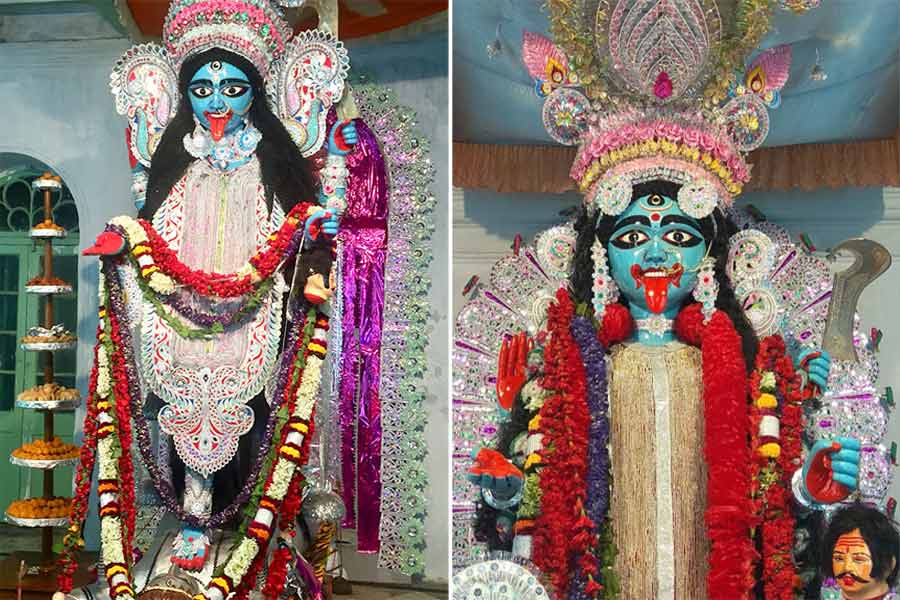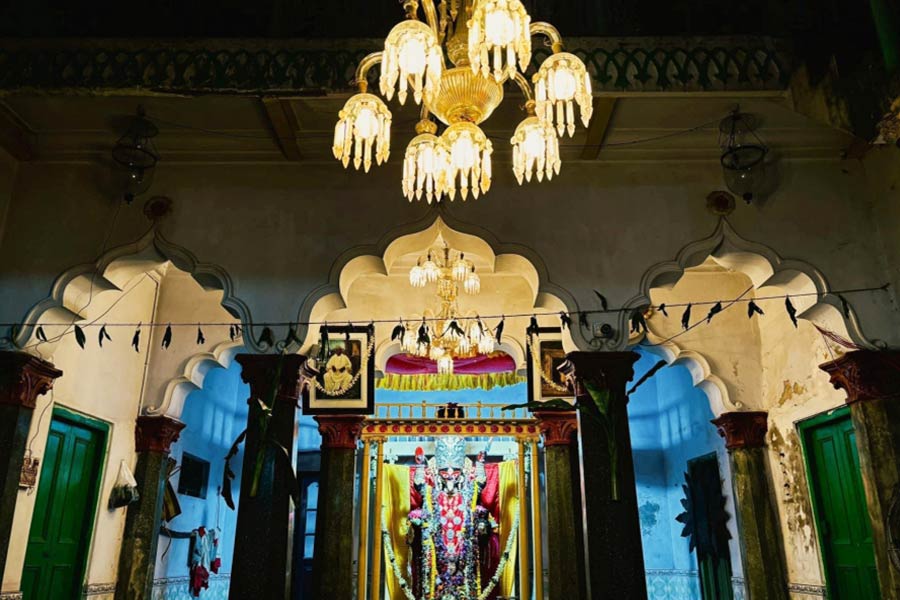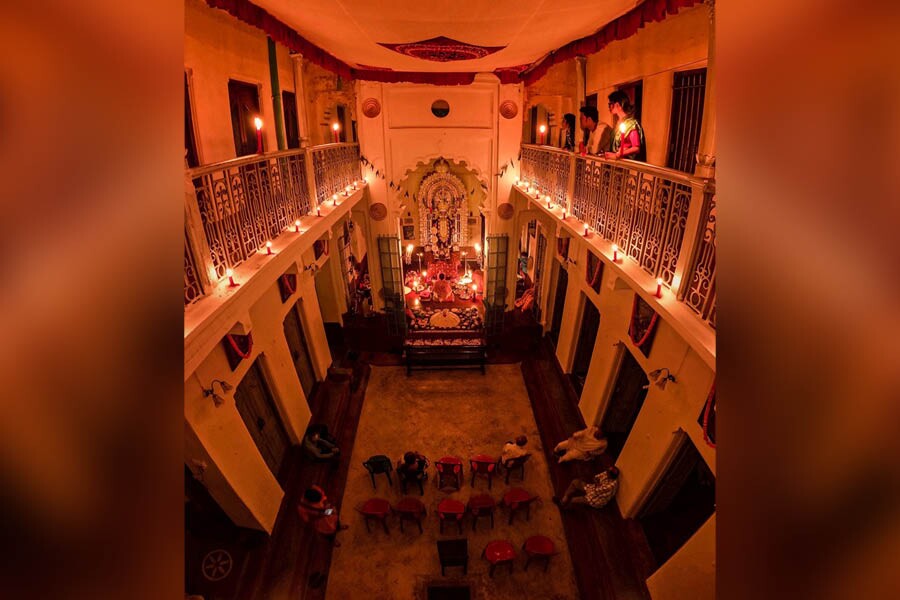Why is goddess Kali of Chorbagan Mitra family known as Mithai Kali? Advocate Anirban Mitra looked at me with a smiling face sitting at his chamber inside the palatial mansion of Chorbagan Mitra family at Muktaram Babu Street near Ram Mandir on Chittaranjan Avenue.
The Mitra family has two sections — baro taraf (senior lineage) and chhoto taraf (junior lineage). The entry to the chhoto taraf residence is from the 84, Muktaram Babu Street address, which was earlier the Bahir Mahal or outer part, while the entry to baro taraf is from the 1 Mitra Lane, which is a narrow lane besides the house. Anirban Mitra belongs to the baro taraf of the family.
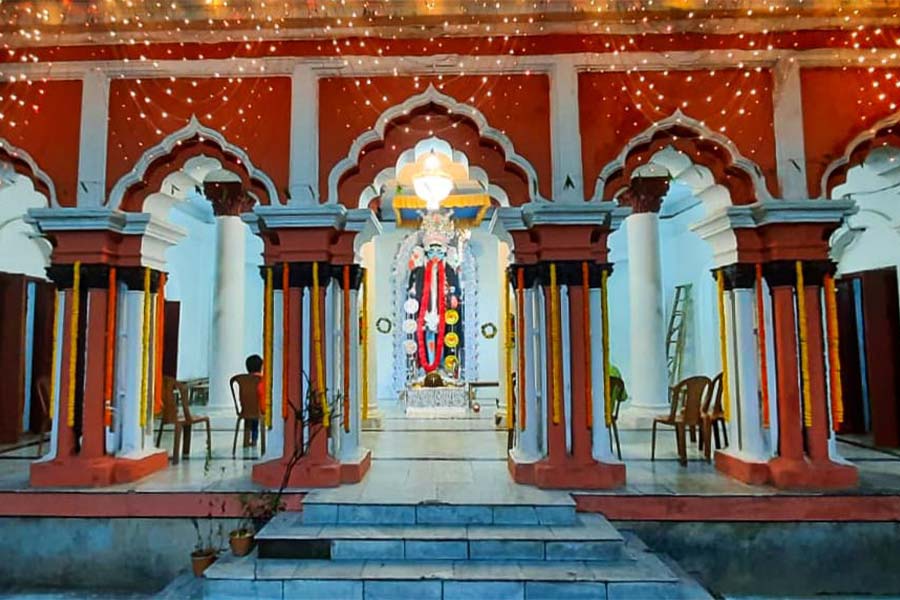
Corinthian pillars adorn the ‘thakur dalan’ of the Chorbagan Mitra family Photograph courtesy: Chorbagan Mitra family
Anirban said that the height of their goddess is round 9 feet. There was a time when sweets were piled till the full height of the deity. It is not possible to offer that the quantity of sweets in the present day but the family tries to provide sufficient quantity of sweets as offering. At present, a nine-tier dessert stand laden with various kinds of sweets towering to a height equal to the shoulder of the goddess is offered. The name ‘Mithai Kali’ is derived from these offering of sweets. The sweets are later distributed to the poor.
Anirban’s brother, Arnab, divulged that the family had moved from Konnagar to Kolkata. They came to their present address, when the area was known as Sakherbazar around 300 years ago. The family originated from members of the Kulin Kayastha caste who came from Kannauj.
Debasish Bandopadhyay has a chapter narrating the history of Chorbagan Mitra family in his famous book Bonedi Kolkatar Ghorbari.
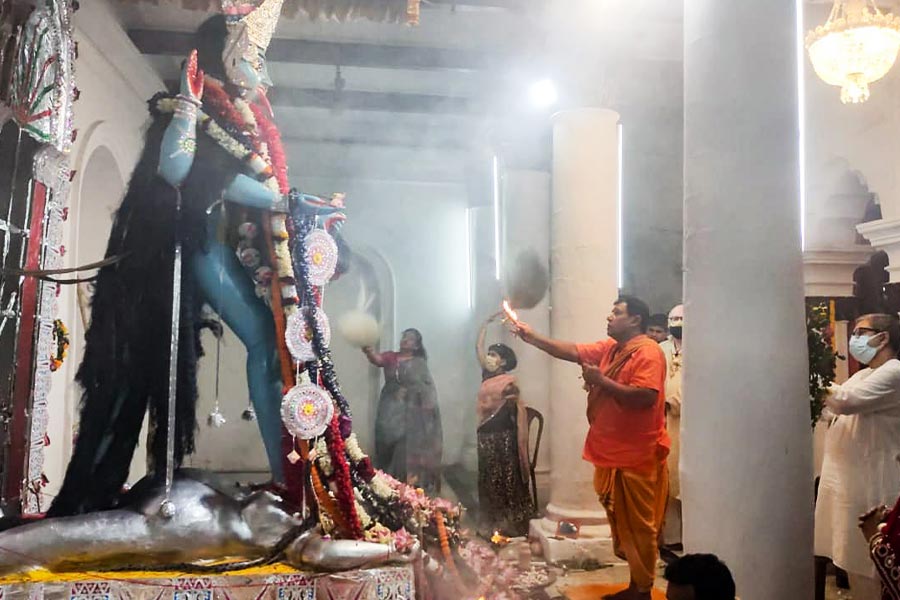
‘Arati’ in progress at the Chorbagan Mitra family residence Photograph courtesy: Chorbagan Mitra family
Bandopadhyay mentions that the area was known Chorbagan long time back because of the presence of dacoits in the vicinity. Later in the 18th century, the place transformed into a residential neighbourhood and once a busy market named Sakherbazar stood here. The chapter narrates a detailed description of the family.
Ramram Mitra of this family was dewan of a nawab at Murshidabad. After earning enough wealth, Ramram settled down at Gobindapur village, which was located near the present-day Fort William. When the British East India Company annexed land for building the present Fort William, Ramram was allocated land in Machuabazar area.
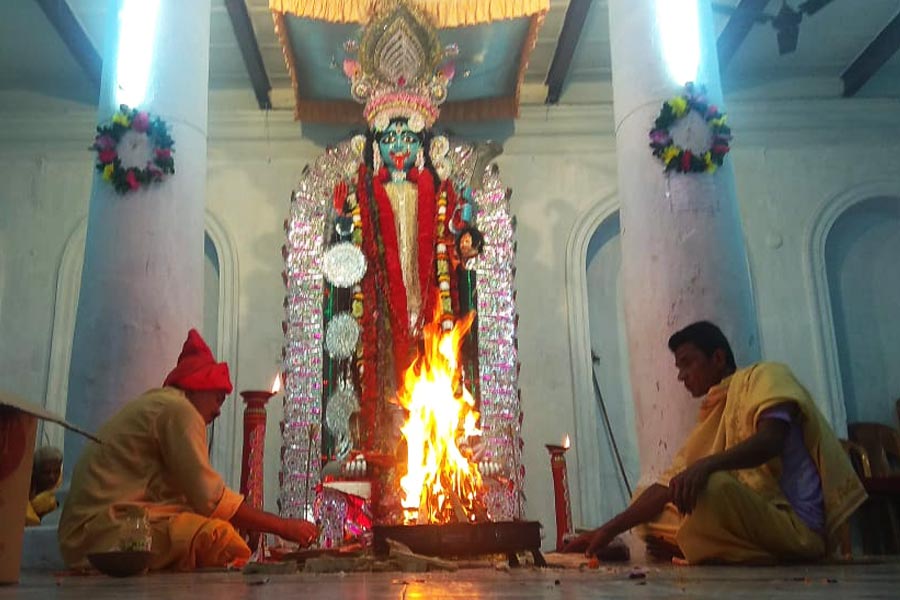
Priests conduct the ‘home yagna’ Photograph courtesy: Chorbagan Mitra family
Ramram’s son, Ajodhyaram, shifted to this area and built a house. He had two sons, Kriparam and Jagannath. After division of family assets, Kriparam moved to Sura village (present-day Beliaghata), while Jagannath stayed on at his ancestral property.
Jagannath Mitra’s son, Ramsundar Mitra, who was well known as Khyandaram Mitra had built up the house to its present state. Ramsundar had assigned the job to Mackintosh Burn and Company. They rebuilt the house adding large Corinthian pillars and portico.
Arnab Mitra explained that the Kali Puja was started in this mansion by Ramsundar Mitra because of divine intervention in 1750. Ramsundar had a dream about goddess Kali describing in details about the face, design, ornamentation and even the height of the goddess apart from the details of the artisan who will prepare the idol.
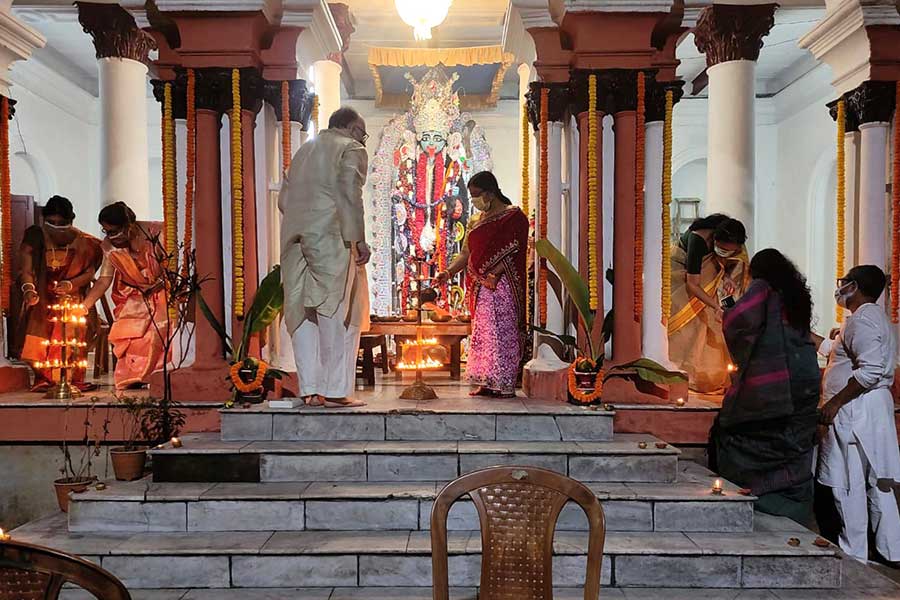
‘Jhar pradeeps’ (multiple brass lamp stands) are lit during Kali Puja Photograph courtesy: Chorbagan Mitra family
The goddess is built in the thakur dalan by artisans down the generations. Kathamo (framework) Puja takes place on Janmashtami and the idol-making starts after Kojagari Lakshmi Puja.
The deity is Shyama here with bluish complexion and is a form of Dakshina Kali. The deity is covered in the front with a decorative design element of daaker saaj, which features a long string of white beads from her neck to almost near her feet. Another unique decorative element is several lotuses made of wax with a bee in the middle. These are placed within the garland of skulls hanging from the deities’ neck. Earlier, the crown or headgear was made of reels of metallic wires but from last year, the Mitras have adorned the goddess with a silver crown. The khnara held by the goddess is made up of silver and so are the two mols (anklet bells) on her feet. The nose ring is made of gold. There is a beautiful chalchitra with daaker saaj decorations as a backdrop to the goddess. The deity stands on a raised platform underneath which is fresh clay from the bank of Ganges with paanch kolai (five pulses) and pancha soshya (five types of foodgrains) spread on it followed by the sprinkling of some holy water.
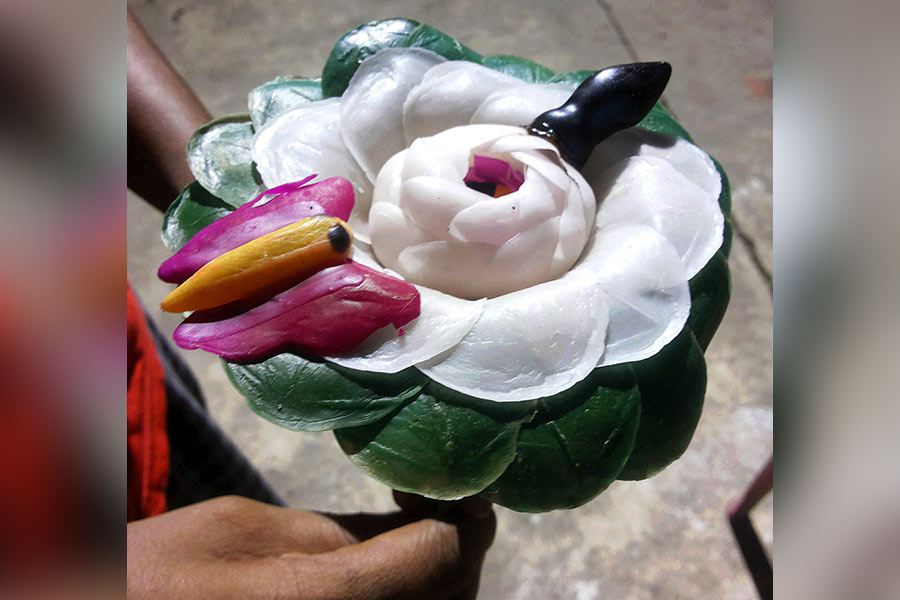
Several wax-made lotus with a bee in the middle are placed within the garland of skulls hanging from the deities’ neck at the Chorbagan Mitra family residence Photograph courtesy: Chorbagan Mitra family
On a daily basis, the Chorbagan Mitra family worships Vaishnava deities Radhagobinda and Sridhar. Kali is thus worshipped here as per Vaishnava rituals, so no animal sacrifice is practised. In earlier days, ash gourd and sugarcane were sacrificed by cutting them into two. At present, they are not sacrificed but offered to the goddess. Also due to Vaishnava rituals instead of liquor, daab (coconut) water is offered as karon (liquor) to the goddess. The family members maintain a strict vegetarian diet during the puja. Those who offer pushpanjali, they do not intake any rice meal.
The objects kept on the baron dala or the offering /welcoming tray for the goddess are dry paddy, barley, brass lamp, sindur chubri (bamboo container decorated with cowrie or shells consisting of sindoor (vermilion), mirror and comb), liquid sindoor, one saree, one dhoti each for Mahadev and family deities, small stone piece, a bunch of kathali banana, turmeric, Aguru, kajallata, ganga mati, cowrie, altapata, gota moong, belerics, supari, pithuli, haritaki, amloki, til, maskolai, camphor, small garland of beads, panchabati garland, scented oil, water and soap, Latai for wrapping threads, elements of gold, silver and copper, shankha, pala and noya (worn by Hindu married women).
The main naibedya (which the Mitras refer as mahaprasad) is kept on a large brass plate known as parat on wooden benches having alpona decorations on them in front of the goddess. It contains 7 to 8kg of uncooked rice with a soggy mass of coconut in the centre. Surrounding the parat are small containers with different food elements are kept on similar benches. These food elements include soaked gota moong, soaked sona moong, aamsotto (mango candy), cashew nuts, raisins, daab water, chandrapuli, coconut naru, tilkut, turmeric, cardamom (small and big) and clove and sandesh. The other naibedya items are kept in lotus-shaped brass plates known as Padma Kata Thala.
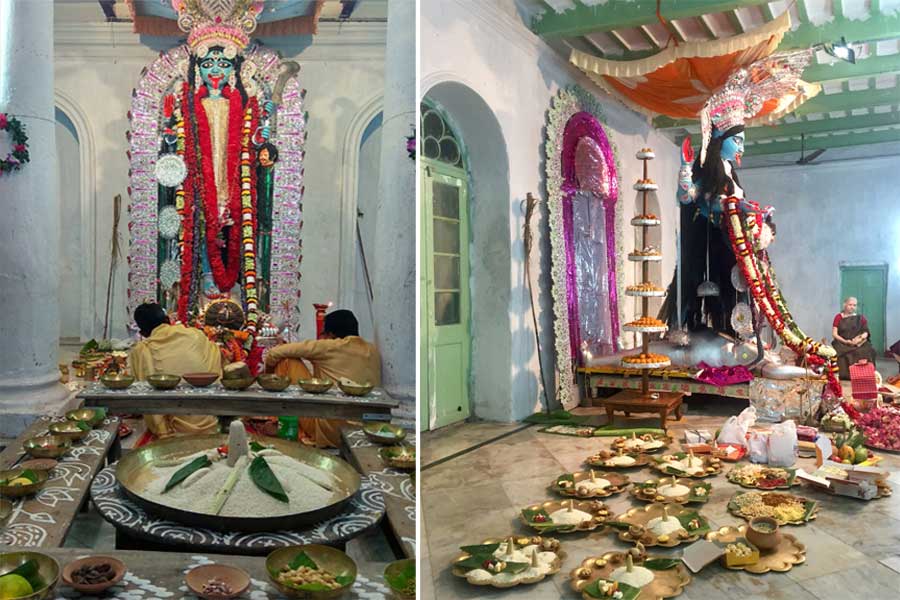
The main ‘naibedya’ (which the Mitras refer to as ‘mahaprasad’) is kept on a large brass plate known as ‘parat’ and (right) other ‘naibedya’ are kept in lotus-shaped brass plates known as ‘padma kata thala’ Photographs courtesy: Chorbagan Mitra family and Kinjal Bose
Cooked food offering to the goddess includes over 150 luchis, alu dam, chholar dal, six kilos of darbesh, jalbhara sandesh, ledikini, gaja (50 pieces each).
The main ghot for worship is made of clay with decorations on it. Inside the ghot are placed pancha ratna (representative relics of five gemstones), Pancha guri (Fine powder of turmeric, rice, dried flower, chaff and leaves of wood-apple tree) and pancha pallab (ritual assortment of five different leaves — ashok, ashvattha, mango and yagga dumur (cluster fig).
108 doob grass along with 100 unbroken grains of rice are wrapped inside an altapata are tied with a red thread to make the special arghya (offering to the goddess) at the Haldar residence which is an is an important part of the household Kali Puja. Usually only one arghya is made and offered to the goddess even in a joint family. However, in the Chorbagan Mitra family, multiple arghyas are made for each member of the family. The arghya is not shared with anyone.
After the ghot is set, the rituals of driving away Alakshmi (goddess of misfortune and misery) takes place. No idol of the goddess is made but the necessary chanting of mantras takes place followed by the symbolic noise of hitting an abandoned kulo (bamboo tray) as non-members of the house take the kulo out of the house and place it somewhere far away from sight. Then the puja of goddess Dhanya Lakshmi starts. Four sindoor kouta (vermilion pots) are kept on four sides of the Dhanya Lakshmi, each container having an Akbari mohur.
The Kali Puja starts shortly after the abovementioned ritual. Before the main puja takes place, the goddess is offered a garu (water pot with long long neck), gamla (tub), turmeric paste, salt, tongue cleaner, scented oil and a gamcha for keeping herself ‘fresh’ before the Puja.
The ritual of chokkhu daan follows the ritual of pran pratistha. This is a ritual to establish the spirit of a goddess inside a clay idol. This follows an arati in front of the goddess which involves ritually waving light from a flame to venerate the deities. The rituals of the main Kali Puja start at the end of this arati.
When the rituals of the puja are about to end, 108 lotus flowers are offered to the goddess. Then the sugarcane and ash gourd are offered to the goddess. After this, jhar pradeeps (multiple brass lamp stands) are lit. The priest dedicates the light from these lamps to the goddess. The main arati of Kali Puja takes place after this which is followed by Pushpanjali to the Goddess. Soon after pushpanjali, Kumari Puja takes place which is a unique ritual of the Chorbagan Mitra family as because usually Kumari Puja takes place during the autumn worship of Durga. Finally, home yagna takes place followed by immersion of the goddess at Nimtala Ghat. There is no practice of sindoor khela or a pradakshina around the goddess by married women as a part of baron rituals.
After immersion of the deity at Nimtala Ghat, the priest hands over the multiple arghya offered to the goddess to individual family members.
